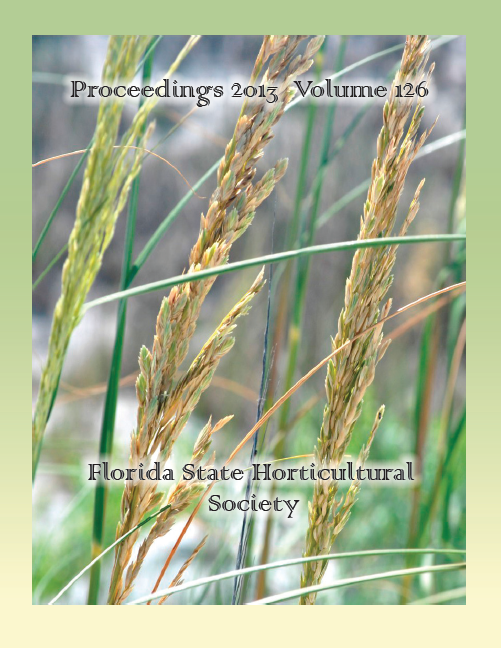Published 2013-12-01
Keywords
- yellow nutsedge,
- purple nutsedge,
- Cyperus esculentus,
- Cyperus rotunda,
- glyphosate
- cultivation,
- 1,
- 3-dichloropropene chloropicrin,
- dimethyl-disulfide ...More
Abstract
The objective of this study was to establish the impact of glyphosate and cultivation during the fallow period on fumigation requirements for nutsedge control in bell pepper. Studies were conducted at PSREU at Citra, FL, and GCREC at Balm, FL in 2012. Cultivation (C) was applied with a rototiller and glyphosate (G) was applied at 5.51 kg·ha–1 with a backpack sprayer. The timing of treatments were based on an 18-week fallow period: G or C at 9 weeks after initial (WAI) cultivation; GG, CC, GC, or GG at 6 and 12 WAI; GCG at 4, 9, and 14 WAI; and a nontreated control. The three fumigant treatments were 1,3-dichloropropene + chloropicrin (337 kg·ha–1), dimethyl-disulfide (595 kg·ha–1), and a nonfumigated control. Nutsedge plants were counted with a 1-m2 quadrant and bell pepper fruit were harvested at maturity. At 14 days after planting (DAP), the nontreated and C fallow treatments had the greatest nutsedge populations (8 and 6 nutsedge/m2). At 42 DAP, the populations in the nontreated control (16 nutsedge/m2) was greater than in all the treatments that had received glyphosate or cultivation (3 to 8 nutsedge/m2). The lowest nutsedge population resulted from GCG (3 nutsedge/m2) and was similar to the fallow programs that required two inputs during the fallow period. In the nontreated fallow program, applying DMDS or 1,3D+Pic lowered nutsedge population at 42 DAP compared to the nonfumigated control. In the plots treated with CG, GG, or GCG during the fallow period, no differences were observed in among fumigation treatments for nutsedge control. Fallow program did not have an impact on fruit yield. A fallow weed management program that uses more inputs leads to less reliance on fumigation for weed control.

